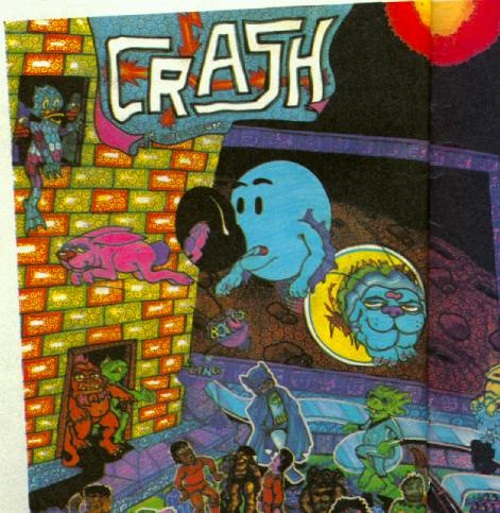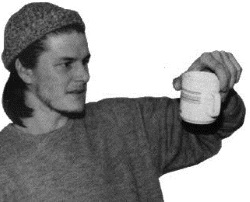
Lee Paddon persuaded Jon Ritman and Bernie Drummond to break a journey between London and Manchester and drop in to the Towers for a chat...
The graphical capabilities of the current generation of home computers are limited, and even the most talented artist is restricted by the nature of the medium when it comes to putting art on the screen. So why did Bernie Drummond, the man behind Batman’s graphics choose a life of pixel prodding?
Well, one answer could be that there’s money in it. For the latest game to emerge from the mind of Jon Ritman, Head over Heels, the advance royalties alone from OCEAN will net Bernie over £14,000. This isn’t bad for someone who managed to fail his art CSE!
Bernie Drummond is unashamed about his lack of formal academic qualifications: “I failed the CSE deliberately. I knew the sort of thing the teacher was looking for and I didn’t want to do it his way. I think formal art tuition is a real waste of time. You spend all your time studying other artists and learning how to use knives. That’s not what interests me.”
Bernie got interested in drawing when he started doodling characters from his favourite cartoon strips. One of his chief sources of inspiration was the X-Men, a group of teenagers who had mutant powers. Guided by their mentor, Professor Xaviour, the X-Men went around conquering evil. “I liked them because they were just ordinary kids, not superheroes: you could really identify with them — it was also very well drawn. I like Neil Adams a lot. It’s amazing the way he moves from comic to comic, taking a really awful strip that’s struggling for survival and turning it into the most popular strip in a matter of months. He’s great for detail like drips of sweat on foreheads. Barry Smith’s good as well — he draws Conan the Barbarian.”

Bernie believes that the best way to develop your own style is just to draw as many things as possible, experimenting with different materials. Like our own Oli Frey and his airbrush, Bernie is inseparable from his set of felt pens. “By just drawing as much as possible, you build up a portfolio in your head. I always start with eyes. I can draw eyes really well, so once I’ve got those right, I just work outwards and fill up the rest of the picture.”
Bernie was playing the drums in a band called ‘The Position’ when Jon Ritman first bumped into him. Music is still Bernie’s main interest: “I really prefer music to art — I could go on about that all day if you like.” Jon was a friend of one of the other members of the band, and knew Bernie did art in his spare time. “I think I was actually sticking handles on saucepans for a living at the time.”
Jon had finished writing Match Day and had just started Batman; he’d seen Knight Lore and decided that this was the sort of game he wanted to write next. Recognising that he had to take the basic 3D isometric formula and put in something new, Jon realised that improving the graphics was important. An artist was needed to work on the graphics, and Bernie’s name sprang to mind.
Bernie had never seen a computer game in his life, so Jon sat him down in front of Knight Lore for a while: “but not for too long, as Jon didn’t want me to copy any of the ideas,” Bernie remembers. Then Jon loaded up his home-brewed graphics utility and Bernie started doodling.
“There are many things I like about computer graphics but a lot of drawbacks. Normally on paper I never rub anything out; it just has to work first time. But with computer graphics you can spend absolutely hours putting in a pixel and then rubbing it out. You never have to repeat things either — once a sprite is drawn, you can just pick it up again and fiddle around with it.” But there are limitations as well. All the graphics have to fit in an area three character blocks high and three block wide. That’s 24 pixels square, in other words a little over 500 picture elements in total to play with. That’s not much, and Bernie often can’t tell what a graphic is going to look like until it is in the game and trotting around.
“Many of the graphics in Batman just came about by EX-ORing (superimposing) two bits of graphics over each other, and something would suggest itself to me.” Jon gave him a totally free hand with objects and wall decorations. “He never said ‘draw me a chair over there’ — I’d just come up with something and he’d fit it into the scenario.” Most of Bernie’s main characters adhere to strict proportions: they are always one-third legs, one-third body and one-third head. Not only does this mean he can try to create new characters by EX-ORing old ones on top of one another; it also means a character can have a lot of facial detail. Batman was licensed, which complicated the development of the graphics somewhat — all Bernie’s work had to be approved by the American copyright holders before the finished game could be released.

Jon is giving Bernie a totally free hand with the graphics for Head over Heels (previewed overleaf). The castle theme of the first part of the game came about because Bernie produced a graphic for a suit of armour. So Jon had to stretch the plot a little. Suits of armour in a space fantasy game? Well, obviously the evil Dictator had seen too many old Errol Flynn movies! One of the other planets in the game, the Book World, is full of Western-type graphics, so the film theme runs right through the game.
Bernie lives at home, and at first his parents criticised his eccentric lifestyle — until the cheques started to arrive. “I work in bursts, I’ll do virtually nothing and then go totally mad and work round the clock once I’ve got into a game.” But he has never forgiven his Spectrum for throwing out a file on a Microdrive. It represented well over a day’s work. He now works on an Amstrad and only transfers his work to the Spectrum to see how it will look.
The batch of Bernie’s computer graphics should see the light of day on Three and In. The game is being written by Chris Clarke, Jon’s old Match Day collaborator. Chris has been working on this game since he and Jon finished Match Day. It’s based on the old playground game where some poor sap would be stuck in goal, and his mates would try to score goals. The first to score three goals changed places.
For Three and In, Chris plans to allow up to three players to compete at once, one controlling the goalkeeper and the two others taking the defence and attack — controlling two footballers each. When Bernie started working on the game, Chris had the figures moving and Bernie got involved with ‘filling them out’ — giving them convincing arms and legs.
The screen will look similar to the end-on view of Handball Maradona and Footballer of the Year “but hopefully there will be lots more gameplay,” Bernie asserts.
All this should come in handy for Jon’s next project which should take up where Match Day left off. According to Jon there’s still plenty of room for a follow up. “I haven’t seen anything better than Match Day so far. Super Soccer was okay if you persevered, but it did have some horrific bugs in it, like when players didn’t get up after being fouled.” Like all programs, the features that are planned for the follow-up to Match Day will be a compromise between desirability and time. “Sliding tackles are nice, but they use a lot of animation to do them properly. More importantly, I’m going to have to make the whole game harder — Bernie can beat the computer on Professional level 22-0.” Jon also hopes to improve the way the goalkeeper moves in the sequel to Match Day. (A common criticism of Match Day is that it is too easy to score by walking the ball into the net, thus avoiding triggering the goalkeeper.)
But then Match Day is Bernie’s favourite computer game: “it was the first computer game I’d ever played for any length of time, so I was rather spoilt and I tend to be hypercritical of other games. Everything is so realistic, when I show someone the different ways the ball bounces off a player’s chest (depending on whether you are moving towards or away from the ball at the time) they don’t believe it and think it is just a fluke or a bug. The collision detection is brilliant as well — the ball only bounces when it actually strikes something, instead of when it comes near. The animation is also nicely done. It is important when a player is running, that each foot lands and then stays on the ground while the other foot comes forward, That sounds so obvious, but it’s amazing how many sprites you see apparently running on the spot.”
When he’s not playing around with pixels, Bernie has three main interests which verge on the obsessive: music, football and eating. He has a massive collection of records which he leaves all over the place. “I generally only like one or two tracks from an album, so I’ll tape those, and then probably take the album round to a friend’s house and forget I’ve left it there. I like a lot of classical music, particularly Prokoviev and Bartok. There’s such a lot going on in their music. This band I used to play in had this idea where we’d try and cram as many riffs into a song as possible. The tune might only last a minute or so in the end, but there would be about twenty or thirty different things in there.”
In terms of contemporary music, Kate Bush and The Fall feature regularly on the Drummond turntable. Kate Bush’s early songs are particular favourites. “The Dreaming is her best album. She uses music very well: things like sudden silences in just the right place. Once you’re in tune with the ways she thinks, you always know what note is going to come next.”
Foodwise, Bernie is very self-sufficient, and is very wary of additives — indeed suspicious. He only trusts the thins he prepares himself. Although somewhat evasive about his age (he’ll admit to being in his twenties), Bernie believes that his crud-free diet comes in handy when it comes to following his other passions in life, football. When he’s not playing football on a computer screen, Bernie’s usually running round a field full of younger players — most of his contemporaries (including Jon) feel they’re getting a bit too old for the physical rigours of competitive football.
There’s obviously a lot to be said for an additive-free diet...